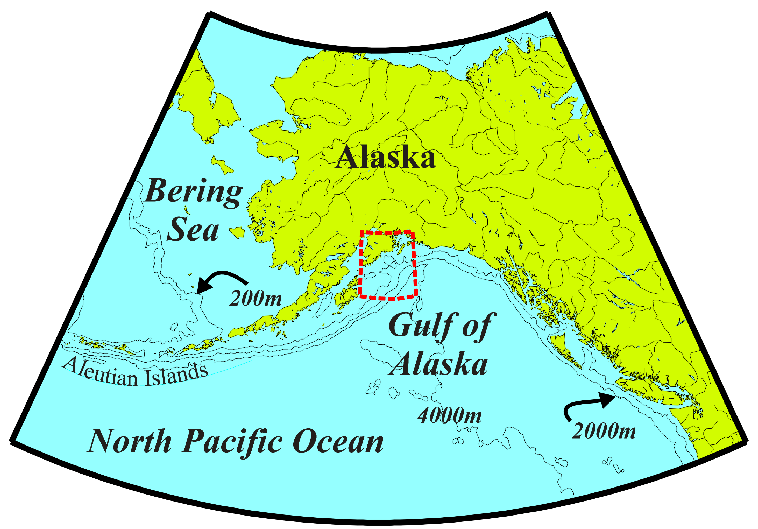What follows is text that was previously posted on the CGOA GLOBEC home page (http://mather.sfos.uaf.edu/GLOBEC/intro/index.html, originally by Dr. Seth Danielson) and describes the state of knowledge at the time that program began. Full citations of references made here can be found at Publications: Early Work.
Marine Ecosystem Monitoring in the Northern Gulf of Alaska
Background: Climate change and its potential effects on ecosystems are of international concern. In response to this issue the Global Ocean Ecosystem Dynamics (GLOBEC) program addresses the physical and biological interactions linking ecosystem alterations to climate change. The GLOBEC program goals are: 1) to understand the effects of climate variability and climate change on the distribution, abundance and production of marine organisms and 2) to incorporate this understanding in diagnostic and prognostic models. The GLOBEC program sampling efforts spanned the years 1997 to 2004. Since 2005, twice-yearly cruises to the northern Gulf of Alaska have been supported by the North Pacific Research Board (NPRB).
The Gulf of Alaska (GOA) shelf supports a diverse ecosystem that includes several commercially important fisheries such as crab, shrimp, pollock, salmon, and halibut (OCSEAP Staff; 1986; Anon., 1993). In aggregate these stocks imply that the gulf is amongst the world’s largest fisheries with annual catches exceeding 300g/1000 m3 (Brodeur and Ware, 1992). The mechanisms that underlie this high productivity are not known and, in fact, are somewhat enigmatic because the GOA shelf is a coastal “downwelling” shelf. By contrast, the rich fisheries along the eastern boundaries of the Pacific Ocean are supported by vigorous, wind-driven coastal upwelling, whereby the euphotic zone is regularly replenished with nutrients advected from depth.
Intriguingly, the relative dominance of the commercially important fish species changed in the mid-1970s; crab and shrimp declined while salmon and groundfish populations increased (Albers and Anderson, 1985; Blau, 1986; Hollowed et al., 1994, Thompson and Zenger, 1994; Francis and Hare, 1994). These population shifts coincided with the beginning of a decadal North Pacific change in the atmosphere and ocean (Trenberth and Hurrell, 1994). From the human perspective these alterations required the commercial fishing industry to invest substantially in infrastructure adjustments so as to remain economically viable. Subsequent changes in this ecosystem followed in the 1980s with substantial declines in populations of sea lions (Merrick et al., 1987) and puffins (Hatch and Sanger, 1992). Dramatic though this “regime shift” was , Parker et al. (1995) show evidence that the abundance of halibut and other commercially important species varies on decadal time scales in conjunction with northern North Pacific Ocean temperatures (e.g., Royer, 1993). These correlations and the regime shift suggest that the GOA ecosystem is sensitive to climate variations on time scales ranging from the interannual to the interdecadal; however, the specific mechanisms linking climate to ecosystem alterations are unknown. Elucidation of these mechanisms requires an understanding of the seasonal cycle of the principle physical, chemical and biological variables. To date such a description is largely lacking for the GOA shelf.
Our monitoring plan will obtain a multi-year data set that will lead to a better understanding of the seasonal cycle and the interannual variability in the physical-chemical structures and biological productivity of this shelf. It focuses on occupations of stations along the Seward Line, including station GAK1 for which there exists a CTD time series extending back to 1970 (Royer, 1996). The 1997-1998 ENSO event did appear at station GAK1 in the form of a positive subsurface temperature anomaly (Royer and Weingartner, 1999).
The Gulf of Alaska Ecosystem Monitoring projects presented here have been supported by the U.S. GLOBEC Northeast Pacific program and the North Pacific Research Board and were designed to yield information essential in
guiding:
- The interpretation of historical data sets that will be used by investigators in retrospective studies.
- The design of a cost-effective long-term monitoring program.
- The design of process specific studies necessary to develop ecosystem models for this shelf.
Primary sampling efforts include the following:
- Occupy the Seward hydrographic line and collect vertical CTD-Chlorophyll-PAR profiles.
- Collect continuous, underway ADCP, sea surface temperature, sea surface salinity, and fluorescence data
- Collect discrete bottle samples for measurements of nutrients, chlorophyll pigments, oxygen isotope ratios, and zooplankton.
- Perform vertical tows for zooplankton and microzooplankton.
- Acoustically determine abundance and distribution of zooplankton.
- Perform MOCNESS tows to help form canonical correlations with the acoustic data.
- Gillnet and midwater trawling to collect fish.
- Determine rates of growth and reproduction of crustacean zooplankton
Ancillary sampling for other researchers is performed on an opportunistic basis. Such sampling has included:
- Bird and marine mammal transects by Dr. B. Day of ABR, Inc and UAF Graduate Student Leandra DeSousa,
- delO-18 samples for Dr. K. Falkner of Oregon State University,
- Stable isotope samples for Dr. T. Kline of the Prince William Sound Science Center,
- Chlorophyll filters for stable isotope characterization for Dr. B. Finney of the University of Alaska,
- Phytoplankton for species identification for UAF graduate student, K. Tamburello,
- Microzooplankton collection and productivity studies for Dr. S. Strom of Western Washington University, and
- Water collection for the micronutrient Iron for Dr. Jingfeng Wu of the International Arctic Research Center.


